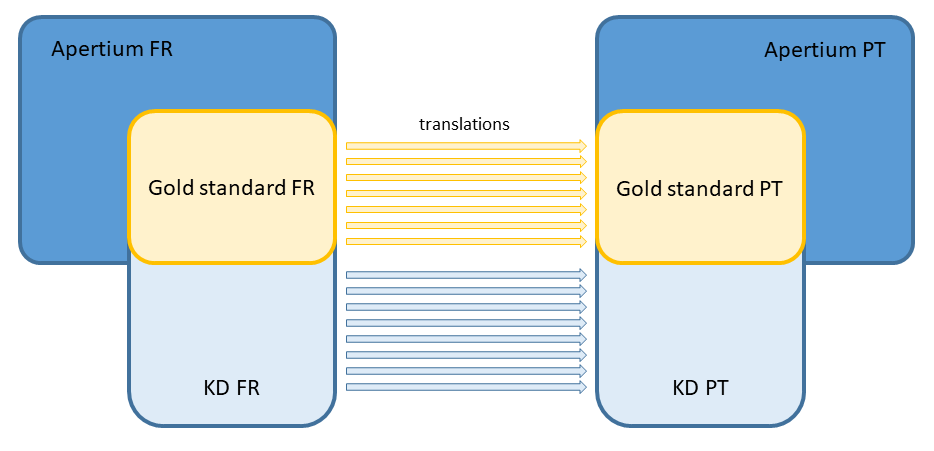Proceedings
The proceedings describing the participating systems and their results have been published online and are available at http://ceur-ws.org/Vol-2493/
Gold standard
To
build the golden standard, we extracted translations from
manually compiled pairs of K Dictionaries (KD), particularly
its Global series. The coverage of KD is not the same as
Apertium. To allow comparisons, we took the subset of KD that
is covered by Apertium to build the gold standard, i.e., those
KD translations for which the source and target terms are
present in both Apertium RDF source and target lexicons. The gold standard remained hidden to
participants. Graphically, for the FR-PT pair:

Evaluation process
For each system results file, and per language pair, we
1.Remove duplicated translations (some systems produced
duplicated rows, i.e., identical source and target words, POS
and confidence degree).
2. Filter out translations for which the source entry is not
present in the golden standard (otherwise we cannot assess
whether the translation is correct or not). Let’s call systemGS
the subset of translations that passed this filter.
3. Translations with confidence degree under a given threshold
are removed from systemGS. In principle, the used
threshold is the one reported by participants as the optimal one
during the training/preparation phase.
4. Compute the coverage of the system (i.e., how many
entries in the source language were translated?) with respect to
the gold standard. Graphically, for the source language:

5. Compute precision as P =(#correct translations in
systemGS) / |systemGS|
6. Compute recall as R =(#correct translations in
systemGS) / |GS|
where GS is the set of translations in the gold standard for a
given language pair
6. Compute F-measure as F=2*P*R/(P+R)
Baselines
We have computed results also with respect to two baselines:
Baseline 1 [Word2Vec]. The method is using Word2Vec [1] to transform the graph into a vector space. A graph edge is interpreted as a sentence and the nodes are word forms with their POS-Tag. Word2Vec iterates multiple times over the graph and learns multilingual embeddings (without additional data). We use the Gensim Word2Vec Implementation. For a given input word, we calculate a distance based on the cosine similarity of a word to every other word with the target-pos tag in the target language. The square of the distance from source to target word is interpreted as the confidence degree. For the first word the minimum distance is 0.62, for the others it is 0.82. So multiple results are only in the output if the confidence is not extremely weak. In our evaluation, we applied an arbitrary threshold of 0.5 to the confidence degree.
Baseline 2 [OTIC]. The One Time Inverse Consultation (OTIC) method was proposed by Tanaka and Umemura [2] in 1994, and adapted by Lin et. al [3] for the creation of multilingual lexicons. In short, the idea of the OTIC method is to explore, for a given word, the possible candidate translations that can be obtained through intermediate translations in the pivot language. Then, a score is assigned to each candidate translation based on the degree of overlap between the pivot translations shared by both the source and target words. In our evaluation, we have applied the OTIC method using Spanish as pivot language, and using an arbitrary threshold of 0.5.
Evaluation results
Table 1: averaged systems results. Results per language pair have been averaged for every system and ordered by F-measure in descending order.
Table 2.1: Systems results for EN-PT. Graph
Table 2.2: Systems results for EN-FR. Graph
Table 2.3: Systems results for FR-EN. Graph
Table 2.4: Systems results for FR-PT. Graph
Table 2.5: Systems results for PT-EN . Graph
Table 2.6: Systems results for PT-FR. Graph
Table 3.1: Results for Baseline1-Word2Vec with variable threshold.
Table 3.2: Results for Baseline1-OTIC with variable threshold.
Table 3.3: Results for Frankfurt with variable threshold.
Table 3.4: Results for LyS with variable threshold.
Table 3.5: Results for LyS-CA with variable threshold.
Table 3.6: Results for LyS-DT with variable threshold.
Table 3.7: Results for LyS-ES with variable threshold.
Table 3.8: Results for ONETA-CA with variable threshold.
Table 3.9: Results for ONETA-ES with variable threshold.
Table 3.10: Results for UNLP-4CYCLE with variable threshold.
Table 3.11: Results for UNLP-GRAPH with variable threshold.
Table 3.12: Results for UNLP-NMT-3PATH with variable threshold.
Table 3.13: Results for UNLP-NMT-4CYCLE with variable threshold.
Graph of the systems results (F1) per threshold.
Table 5: Average number of translations per system.
References
[1] T. Mikolov, K. Chen, G. Corrado, and J. Dean, "Efficient Estimation of Word Representations in Vector Space", 2013.
[2] K. Tanaka and K. Umemura. "Construction of a bilingual dictionary intermediated by a third language". In COLING, pages 297–303, 1994.
[3] L. T. Lim, B. Ranaivo-Malançon, and E. K. Tang. "Low cost construction of a multilingual lexicon from bilingual lists". Polibits, 43:45–51, 2011.